ACCT20074 Contemporary Accounting Theory: Financial Reporting
VerifiedAdded on 2023/03/31
|20
|3945
|228
Report
AI Summary
This report provides an analysis of contemporary accounting theory, focusing on the conceptual framework for financial reporting and its application to ASX-listed corporations like REGENEUS LIMITED (RGS). Part A reviews the history and development of the conceptual framework, examines concerns within the Australian accounting profession, discusses academic perspectives on its quality, and explains its application by RGS. Part B compares sustainability reporting guidelines with the International Integrated Reporting Framework and assesses the strengths and limitations of financial statements within the conceptual framework, using Aspen Pharmacare Holdings Ltd as a case study. The report covers key aspects such as the history of the conceptual framework, qualitative characteristics of financial information, and the role of businesses in society today. This document is available on Desklib, a platform offering a wealth of study resources for students.
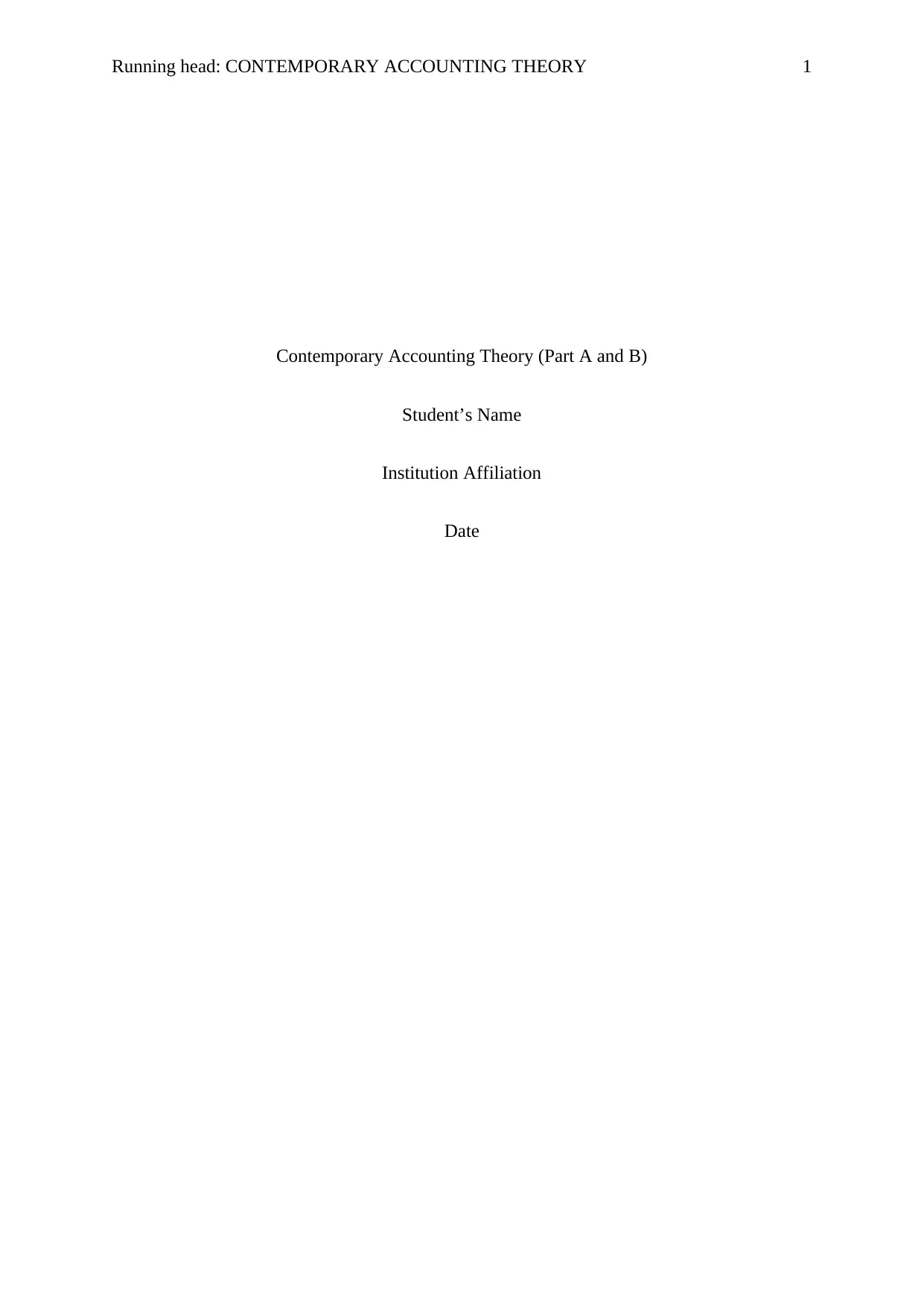
Running head: CONTEMPORARY ACCOUNTING THEORY 1
Contemporary Accounting Theory (Part A and B)
Student’s Name
Institution Affiliation
Date
Contemporary Accounting Theory (Part A and B)
Student’s Name
Institution Affiliation
Date
Paraphrase This Document
Need a fresh take? Get an instant paraphrase of this document with our AI Paraphraser
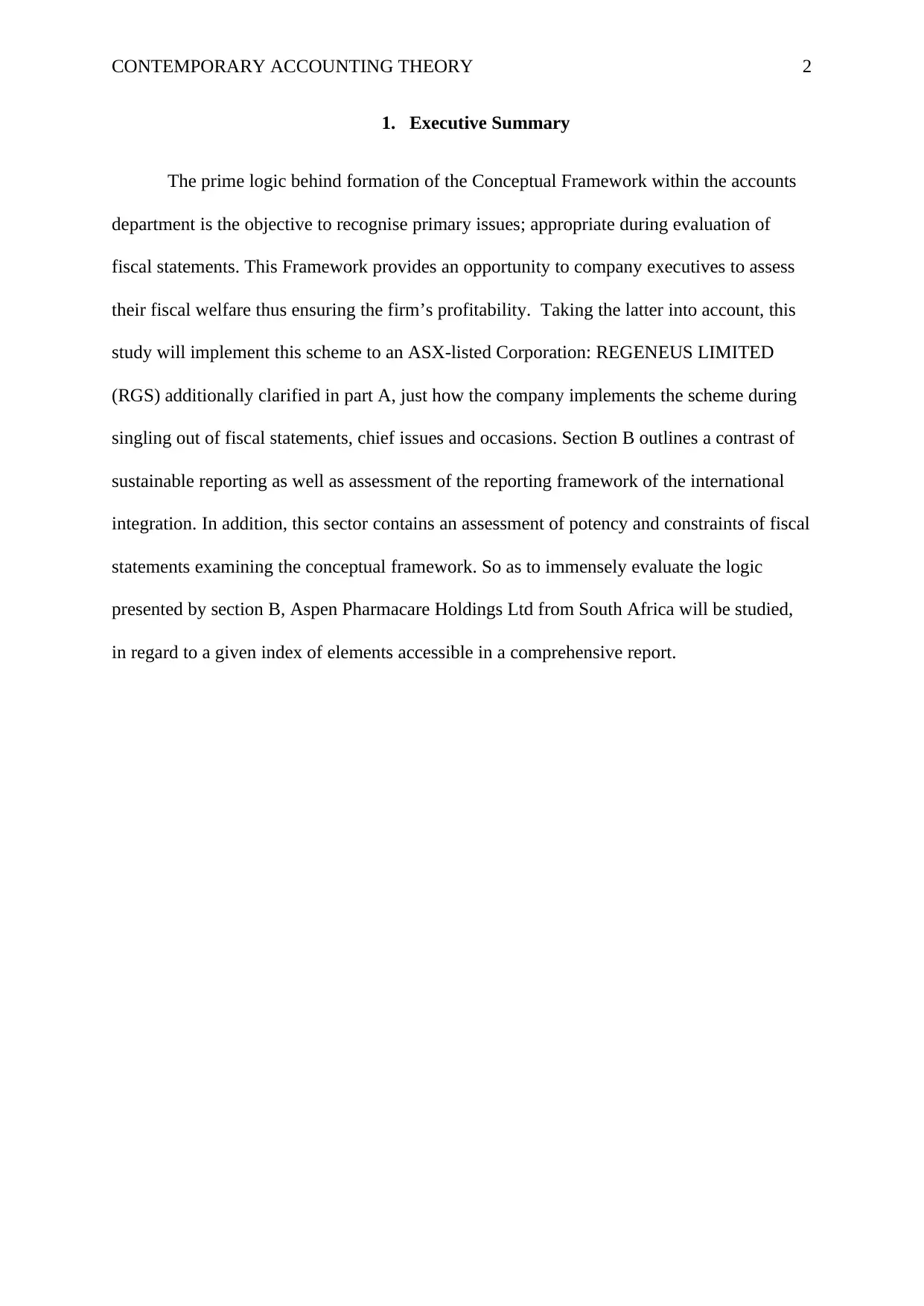
CONTEMPORARY ACCOUNTING THEORY 2
1. Executive Summary
The prime logic behind formation of the Conceptual Framework within the accounts
department is the objective to recognise primary issues; appropriate during evaluation of
fiscal statements. This Framework provides an opportunity to company executives to assess
their fiscal welfare thus ensuring the firm’s profitability. Taking the latter into account, this
study will implement this scheme to an ASX-listed Corporation: REGENEUS LIMITED
(RGS) additionally clarified in part A, just how the company implements the scheme during
singling out of fiscal statements, chief issues and occasions. Section B outlines a contrast of
sustainable reporting as well as assessment of the reporting framework of the international
integration. In addition, this sector contains an assessment of potency and constraints of fiscal
statements examining the conceptual framework. So as to immensely evaluate the logic
presented by section B, Aspen Pharmacare Holdings Ltd from South Africa will be studied,
in regard to a given index of elements accessible in a comprehensive report.
1. Executive Summary
The prime logic behind formation of the Conceptual Framework within the accounts
department is the objective to recognise primary issues; appropriate during evaluation of
fiscal statements. This Framework provides an opportunity to company executives to assess
their fiscal welfare thus ensuring the firm’s profitability. Taking the latter into account, this
study will implement this scheme to an ASX-listed Corporation: REGENEUS LIMITED
(RGS) additionally clarified in part A, just how the company implements the scheme during
singling out of fiscal statements, chief issues and occasions. Section B outlines a contrast of
sustainable reporting as well as assessment of the reporting framework of the international
integration. In addition, this sector contains an assessment of potency and constraints of fiscal
statements examining the conceptual framework. So as to immensely evaluate the logic
presented by section B, Aspen Pharmacare Holdings Ltd from South Africa will be studied,
in regard to a given index of elements accessible in a comprehensive report.
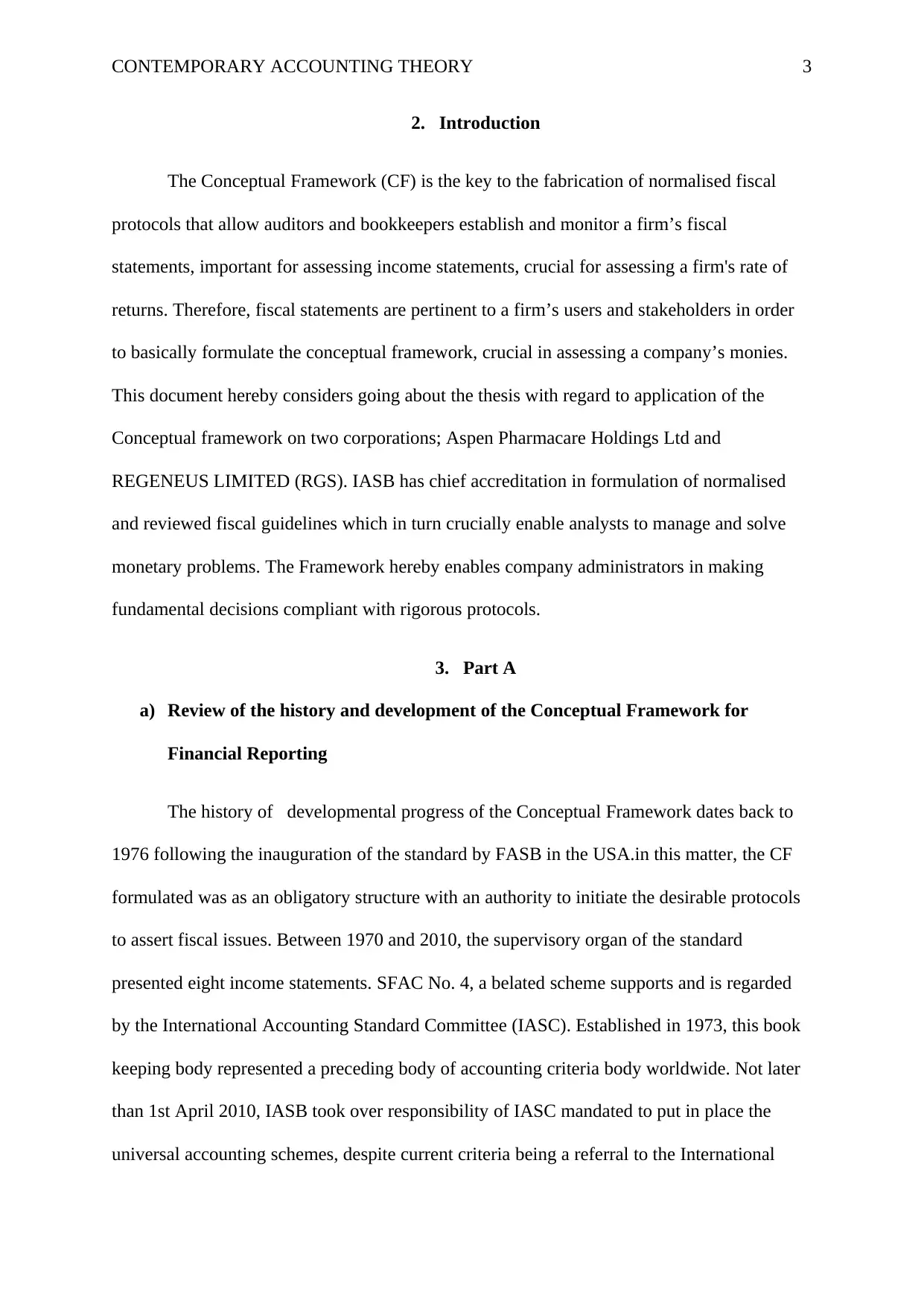
CONTEMPORARY ACCOUNTING THEORY 3
2. Introduction
The Conceptual Framework (CF) is the key to the fabrication of normalised fiscal
protocols that allow auditors and bookkeepers establish and monitor a firm’s fiscal
statements, important for assessing income statements, crucial for assessing a firm's rate of
returns. Therefore, fiscal statements are pertinent to a firm’s users and stakeholders in order
to basically formulate the conceptual framework, crucial in assessing a company’s monies.
This document hereby considers going about the thesis with regard to application of the
Conceptual framework on two corporations; Aspen Pharmacare Holdings Ltd and
REGENEUS LIMITED (RGS). IASB has chief accreditation in formulation of normalised
and reviewed fiscal guidelines which in turn crucially enable analysts to manage and solve
monetary problems. The Framework hereby enables company administrators in making
fundamental decisions compliant with rigorous protocols.
3. Part A
a) Review of the history and development of the Conceptual Framework for
Financial Reporting
The history of developmental progress of the Conceptual Framework dates back to
1976 following the inauguration of the standard by FASB in the USA.in this matter, the CF
formulated was as an obligatory structure with an authority to initiate the desirable protocols
to assert fiscal issues. Between 1970 and 2010, the supervisory organ of the standard
presented eight income statements. SFAC No. 4, a belated scheme supports and is regarded
by the International Accounting Standard Committee (IASC). Established in 1973, this book
keeping body represented a preceding body of accounting criteria body worldwide. Not later
than 1st April 2010, IASB took over responsibility of IASC mandated to put in place the
universal accounting schemes, despite current criteria being a referral to the International
2. Introduction
The Conceptual Framework (CF) is the key to the fabrication of normalised fiscal
protocols that allow auditors and bookkeepers establish and monitor a firm’s fiscal
statements, important for assessing income statements, crucial for assessing a firm's rate of
returns. Therefore, fiscal statements are pertinent to a firm’s users and stakeholders in order
to basically formulate the conceptual framework, crucial in assessing a company’s monies.
This document hereby considers going about the thesis with regard to application of the
Conceptual framework on two corporations; Aspen Pharmacare Holdings Ltd and
REGENEUS LIMITED (RGS). IASB has chief accreditation in formulation of normalised
and reviewed fiscal guidelines which in turn crucially enable analysts to manage and solve
monetary problems. The Framework hereby enables company administrators in making
fundamental decisions compliant with rigorous protocols.
3. Part A
a) Review of the history and development of the Conceptual Framework for
Financial Reporting
The history of developmental progress of the Conceptual Framework dates back to
1976 following the inauguration of the standard by FASB in the USA.in this matter, the CF
formulated was as an obligatory structure with an authority to initiate the desirable protocols
to assert fiscal issues. Between 1970 and 2010, the supervisory organ of the standard
presented eight income statements. SFAC No. 4, a belated scheme supports and is regarded
by the International Accounting Standard Committee (IASC). Established in 1973, this book
keeping body represented a preceding body of accounting criteria body worldwide. Not later
than 1st April 2010, IASB took over responsibility of IASC mandated to put in place the
universal accounting schemes, despite current criteria being a referral to the International
⊘ This is a preview!⊘
Do you want full access?
Subscribe today to unlock all pages.

Trusted by 1+ million students worldwide
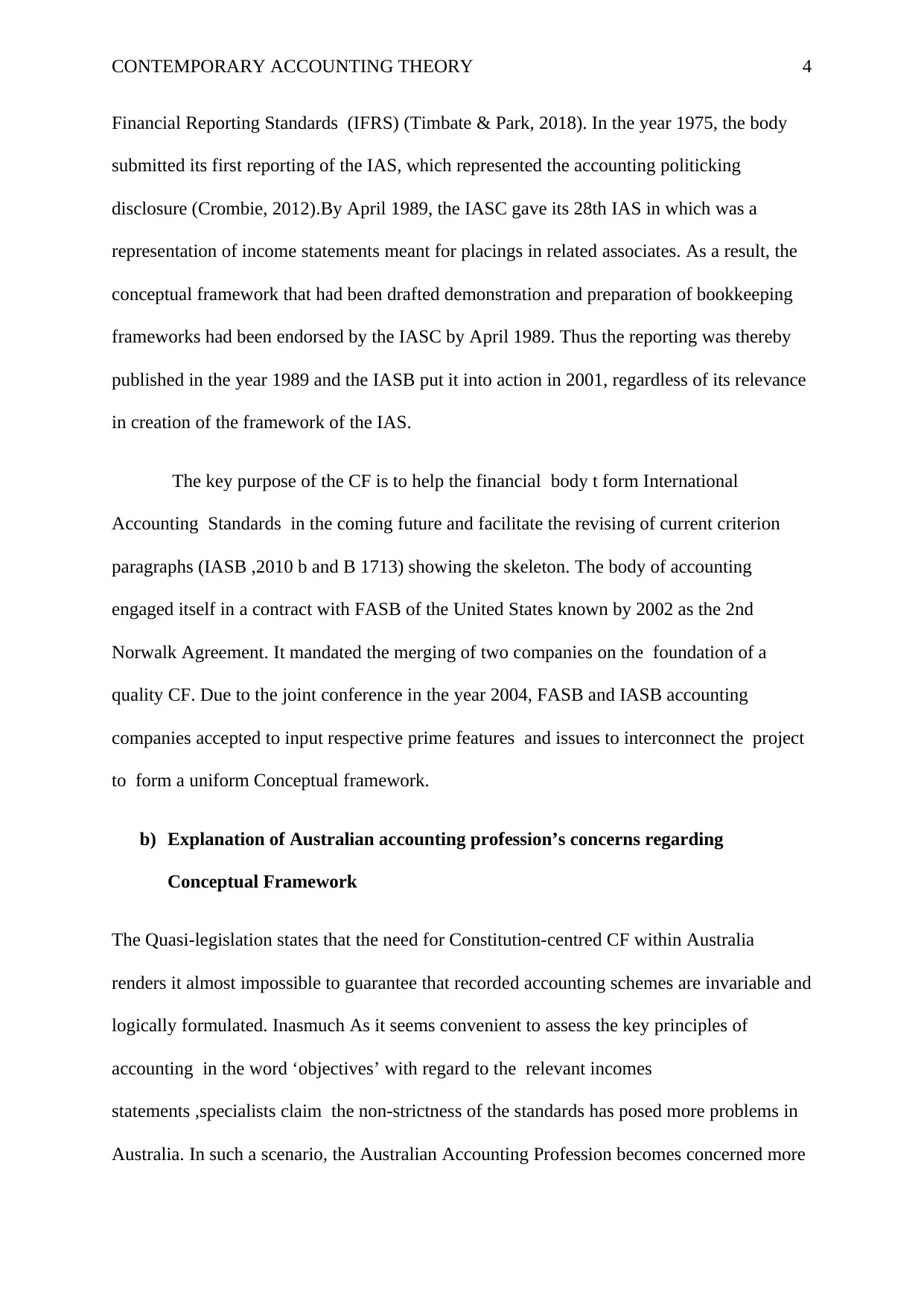
CONTEMPORARY ACCOUNTING THEORY 4
Financial Reporting Standards (IFRS) (Timbate & Park, 2018). In the year 1975, the body
submitted its first reporting of the IAS, which represented the accounting politicking
disclosure (Crombie, 2012).By April 1989, the IASC gave its 28th IAS in which was a
representation of income statements meant for placings in related associates. As a result, the
conceptual framework that had been drafted demonstration and preparation of bookkeeping
frameworks had been endorsed by the IASC by April 1989. Thus the reporting was thereby
published in the year 1989 and the IASB put it into action in 2001, regardless of its relevance
in creation of the framework of the IAS.
The key purpose of the CF is to help the financial body t form International
Accounting Standards in the coming future and facilitate the revising of current criterion
paragraphs (IASB ,2010 b and B 1713) showing the skeleton. The body of accounting
engaged itself in a contract with FASB of the United States known by 2002 as the 2nd
Norwalk Agreement. It mandated the merging of two companies on the foundation of a
quality CF. Due to the joint conference in the year 2004, FASB and IASB accounting
companies accepted to input respective prime features and issues to interconnect the project
to form a uniform Conceptual framework.
b) Explanation of Australian accounting profession’s concerns regarding
Conceptual Framework
The Quasi-legislation states that the need for Constitution-centred CF within Australia
renders it almost impossible to guarantee that recorded accounting schemes are invariable and
logically formulated. Inasmuch As it seems convenient to assess the key principles of
accounting in the word ‘objectives’ with regard to the relevant incomes
statements ,specialists claim the non-strictness of the standards has posed more problems in
Australia. In such a scenario, the Australian Accounting Profession becomes concerned more
Financial Reporting Standards (IFRS) (Timbate & Park, 2018). In the year 1975, the body
submitted its first reporting of the IAS, which represented the accounting politicking
disclosure (Crombie, 2012).By April 1989, the IASC gave its 28th IAS in which was a
representation of income statements meant for placings in related associates. As a result, the
conceptual framework that had been drafted demonstration and preparation of bookkeeping
frameworks had been endorsed by the IASC by April 1989. Thus the reporting was thereby
published in the year 1989 and the IASB put it into action in 2001, regardless of its relevance
in creation of the framework of the IAS.
The key purpose of the CF is to help the financial body t form International
Accounting Standards in the coming future and facilitate the revising of current criterion
paragraphs (IASB ,2010 b and B 1713) showing the skeleton. The body of accounting
engaged itself in a contract with FASB of the United States known by 2002 as the 2nd
Norwalk Agreement. It mandated the merging of two companies on the foundation of a
quality CF. Due to the joint conference in the year 2004, FASB and IASB accounting
companies accepted to input respective prime features and issues to interconnect the project
to form a uniform Conceptual framework.
b) Explanation of Australian accounting profession’s concerns regarding
Conceptual Framework
The Quasi-legislation states that the need for Constitution-centred CF within Australia
renders it almost impossible to guarantee that recorded accounting schemes are invariable and
logically formulated. Inasmuch As it seems convenient to assess the key principles of
accounting in the word ‘objectives’ with regard to the relevant incomes
statements ,specialists claim the non-strictness of the standards has posed more problems in
Australia. In such a scenario, the Australian Accounting Profession becomes concerned more
Paraphrase This Document
Need a fresh take? Get an instant paraphrase of this document with our AI Paraphraser
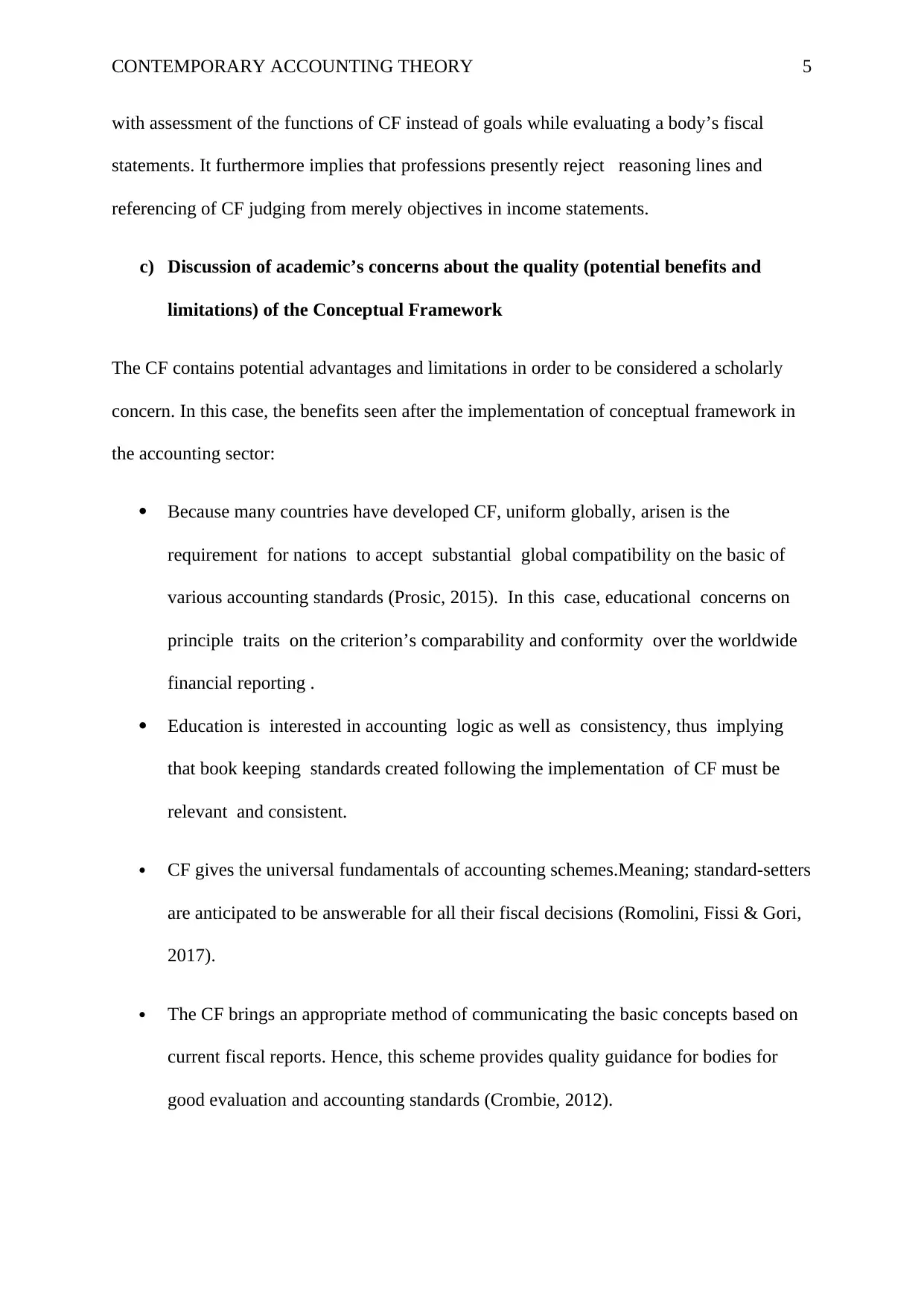
CONTEMPORARY ACCOUNTING THEORY 5
with assessment of the functions of CF instead of goals while evaluating a body’s fiscal
statements. It furthermore implies that professions presently reject reasoning lines and
referencing of CF judging from merely objectives in income statements.
c) Discussion of academic’s concerns about the quality (potential benefits and
limitations) of the Conceptual Framework
The CF contains potential advantages and limitations in order to be considered a scholarly
concern. In this case, the benefits seen after the implementation of conceptual framework in
the accounting sector:
Because many countries have developed CF, uniform globally, arisen is the
requirement for nations to accept substantial global compatibility on the basic of
various accounting standards (Prosic, 2015). In this case, educational concerns on
principle traits on the criterion’s comparability and conformity over the worldwide
financial reporting .
Education is interested in accounting logic as well as consistency, thus implying
that book keeping standards created following the implementation of CF must be
relevant and consistent.
CF gives the universal fundamentals of accounting schemes.Meaning; standard-setters
are anticipated to be answerable for all their fiscal decisions (Romolini, Fissi & Gori,
2017).
The CF brings an appropriate method of communicating the basic concepts based on
current fiscal reports. Hence, this scheme provides quality guidance for bodies for
good evaluation and accounting standards (Crombie, 2012).
with assessment of the functions of CF instead of goals while evaluating a body’s fiscal
statements. It furthermore implies that professions presently reject reasoning lines and
referencing of CF judging from merely objectives in income statements.
c) Discussion of academic’s concerns about the quality (potential benefits and
limitations) of the Conceptual Framework
The CF contains potential advantages and limitations in order to be considered a scholarly
concern. In this case, the benefits seen after the implementation of conceptual framework in
the accounting sector:
Because many countries have developed CF, uniform globally, arisen is the
requirement for nations to accept substantial global compatibility on the basic of
various accounting standards (Prosic, 2015). In this case, educational concerns on
principle traits on the criterion’s comparability and conformity over the worldwide
financial reporting .
Education is interested in accounting logic as well as consistency, thus implying
that book keeping standards created following the implementation of CF must be
relevant and consistent.
CF gives the universal fundamentals of accounting schemes.Meaning; standard-setters
are anticipated to be answerable for all their fiscal decisions (Romolini, Fissi & Gori,
2017).
The CF brings an appropriate method of communicating the basic concepts based on
current fiscal reports. Hence, this scheme provides quality guidance for bodies for
good evaluation and accounting standards (Crombie, 2012).
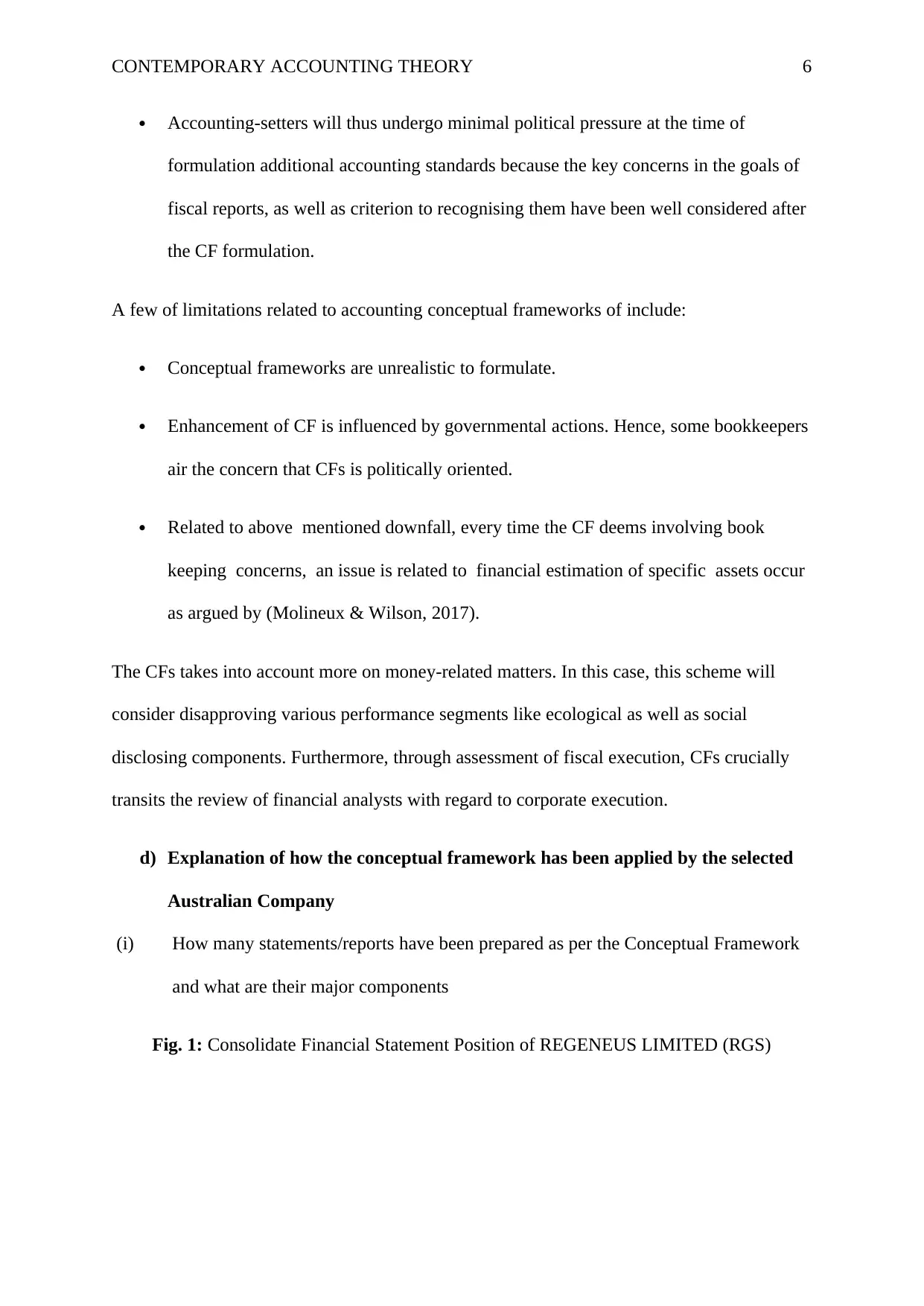
CONTEMPORARY ACCOUNTING THEORY 6
Accounting-setters will thus undergo minimal political pressure at the time of
formulation additional accounting standards because the key concerns in the goals of
fiscal reports, as well as criterion to recognising them have been well considered after
the CF formulation.
A few of limitations related to accounting conceptual frameworks of include:
Conceptual frameworks are unrealistic to formulate.
Enhancement of CF is influenced by governmental actions. Hence, some bookkeepers
air the concern that CFs is politically oriented.
Related to above mentioned downfall, every time the CF deems involving book
keeping concerns, an issue is related to financial estimation of specific assets occur
as argued by (Molineux & Wilson, 2017).
The CFs takes into account more on money-related matters. In this case, this scheme will
consider disapproving various performance segments like ecological as well as social
disclosing components. Furthermore, through assessment of fiscal execution, CFs crucially
transits the review of financial analysts with regard to corporate execution.
d) Explanation of how the conceptual framework has been applied by the selected
Australian Company
(i) How many statements/reports have been prepared as per the Conceptual Framework
and what are their major components
Fig. 1: Consolidate Financial Statement Position of REGENEUS LIMITED (RGS)
Accounting-setters will thus undergo minimal political pressure at the time of
formulation additional accounting standards because the key concerns in the goals of
fiscal reports, as well as criterion to recognising them have been well considered after
the CF formulation.
A few of limitations related to accounting conceptual frameworks of include:
Conceptual frameworks are unrealistic to formulate.
Enhancement of CF is influenced by governmental actions. Hence, some bookkeepers
air the concern that CFs is politically oriented.
Related to above mentioned downfall, every time the CF deems involving book
keeping concerns, an issue is related to financial estimation of specific assets occur
as argued by (Molineux & Wilson, 2017).
The CFs takes into account more on money-related matters. In this case, this scheme will
consider disapproving various performance segments like ecological as well as social
disclosing components. Furthermore, through assessment of fiscal execution, CFs crucially
transits the review of financial analysts with regard to corporate execution.
d) Explanation of how the conceptual framework has been applied by the selected
Australian Company
(i) How many statements/reports have been prepared as per the Conceptual Framework
and what are their major components
Fig. 1: Consolidate Financial Statement Position of REGENEUS LIMITED (RGS)
⊘ This is a preview!⊘
Do you want full access?
Subscribe today to unlock all pages.

Trusted by 1+ million students worldwide
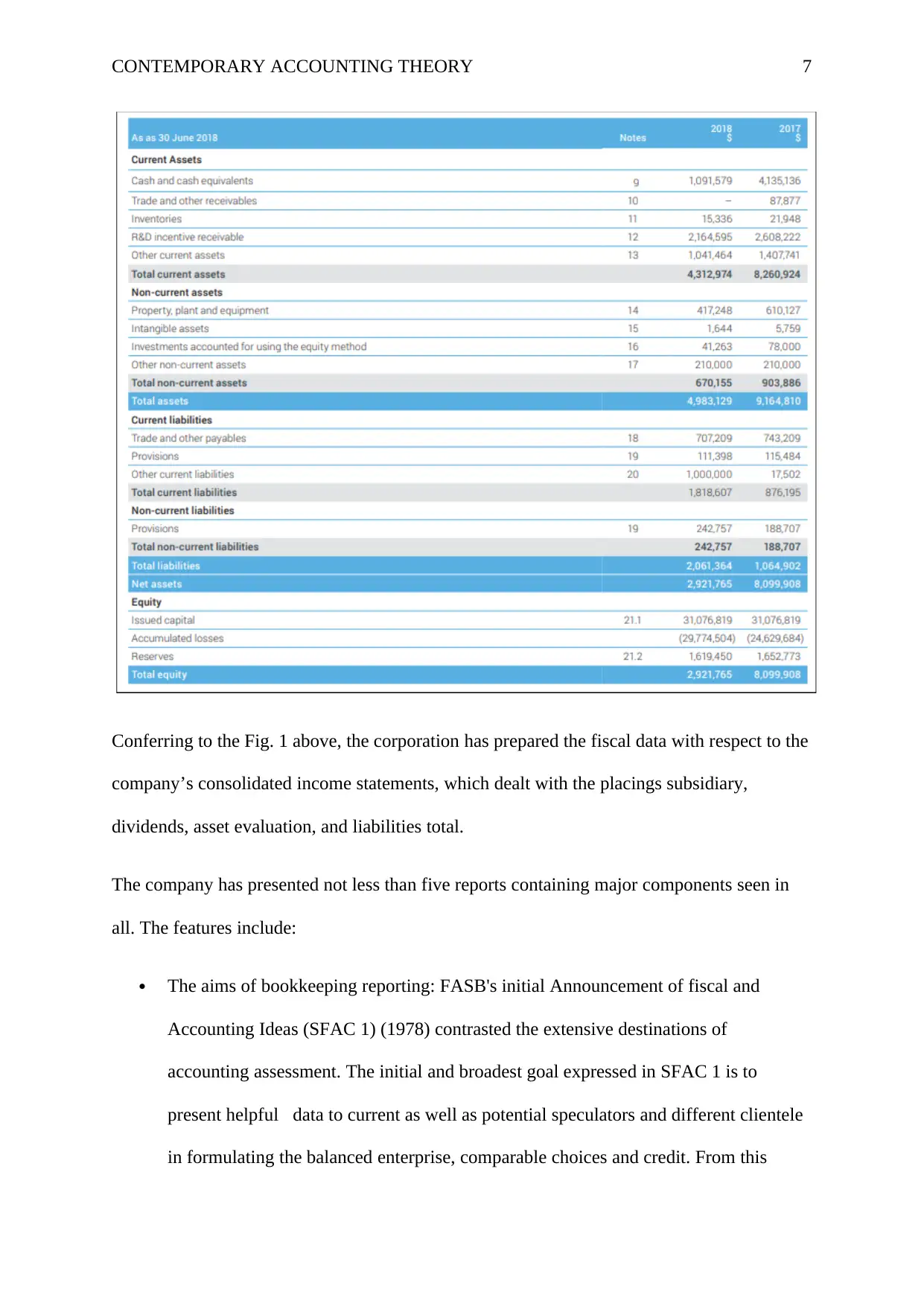
CONTEMPORARY ACCOUNTING THEORY 7
Conferring to the Fig. 1 above, the corporation has prepared the fiscal data with respect to the
company’s consolidated income statements, which dealt with the placings subsidiary,
dividends, asset evaluation, and liabilities total.
The company has presented not less than five reports containing major components seen in
all. The features include:
The aims of bookkeeping reporting: FASB's initial Announcement of fiscal and
Accounting Ideas (SFAC 1) (1978) contrasted the extensive destinations of
accounting assessment. The initial and broadest goal expressed in SFAC 1 is to
present helpful data to current as well as potential speculators and different clientele
in formulating the balanced enterprise, comparable choices and credit. From this
Conferring to the Fig. 1 above, the corporation has prepared the fiscal data with respect to the
company’s consolidated income statements, which dealt with the placings subsidiary,
dividends, asset evaluation, and liabilities total.
The company has presented not less than five reports containing major components seen in
all. The features include:
The aims of bookkeeping reporting: FASB's initial Announcement of fiscal and
Accounting Ideas (SFAC 1) (1978) contrasted the extensive destinations of
accounting assessment. The initial and broadest goal expressed in SFAC 1 is to
present helpful data to current as well as potential speculators and different clientele
in formulating the balanced enterprise, comparable choices and credit. From this
Paraphrase This Document
Need a fresh take? Get an instant paraphrase of this document with our AI Paraphraser
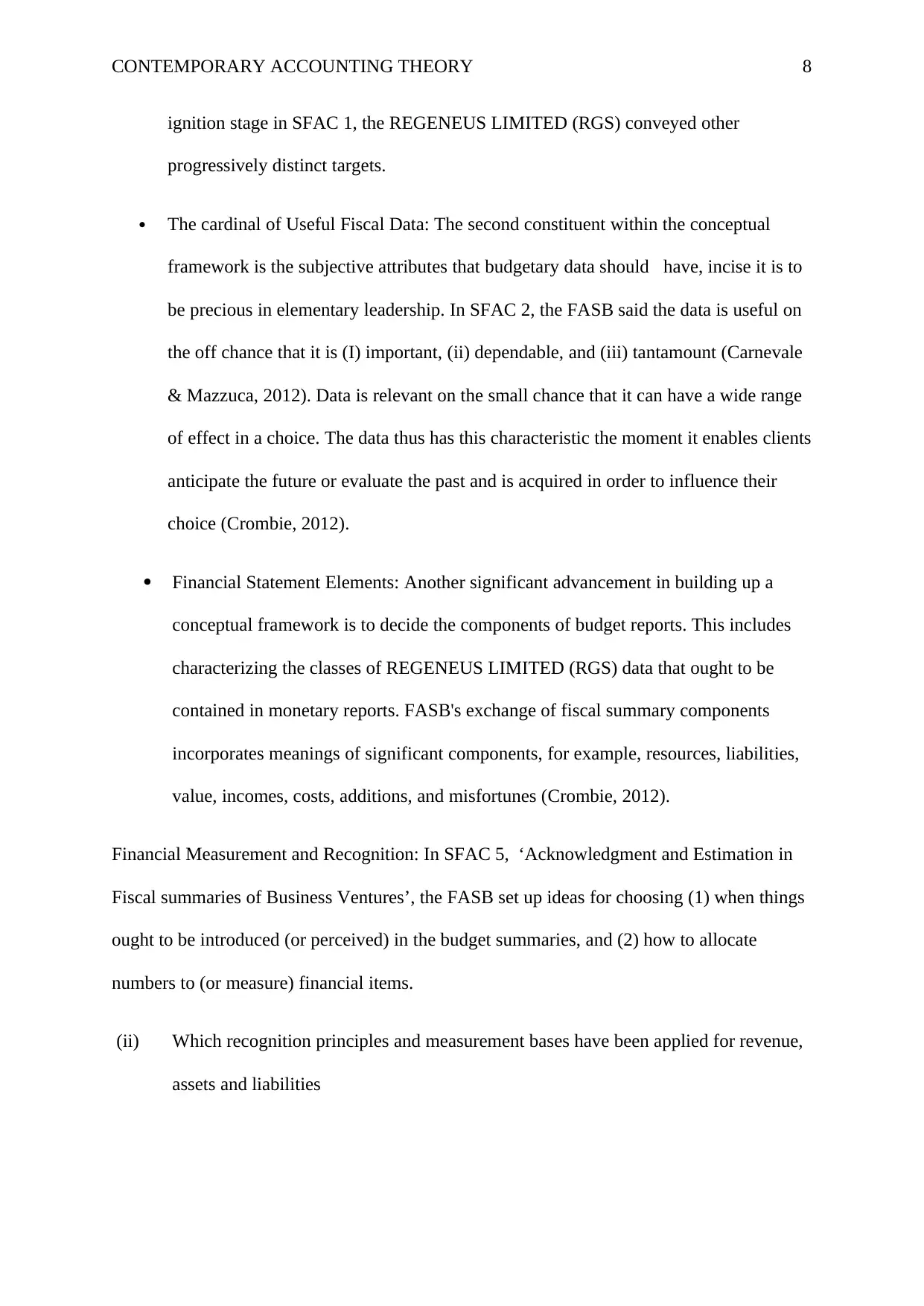
CONTEMPORARY ACCOUNTING THEORY 8
ignition stage in SFAC 1, the REGENEUS LIMITED (RGS) conveyed other
progressively distinct targets.
The cardinal of Useful Fiscal Data: The second constituent within the conceptual
framework is the subjective attributes that budgetary data should have, incise it is to
be precious in elementary leadership. In SFAC 2, the FASB said the data is useful on
the off chance that it is (I) important, (ii) dependable, and (iii) tantamount (Carnevale
& Mazzuca, 2012). Data is relevant on the small chance that it can have a wide range
of effect in a choice. The data thus has this characteristic the moment it enables clients
anticipate the future or evaluate the past and is acquired in order to influence their
choice (Crombie, 2012).
Financial Statement Elements: Another significant advancement in building up a
conceptual framework is to decide the components of budget reports. This includes
characterizing the classes of REGENEUS LIMITED (RGS) data that ought to be
contained in monetary reports. FASB's exchange of fiscal summary components
incorporates meanings of significant components, for example, resources, liabilities,
value, incomes, costs, additions, and misfortunes (Crombie, 2012).
Financial Measurement and Recognition: In SFAC 5, ‘Acknowledgment and Estimation in
Fiscal summaries of Business Ventures’, the FASB set up ideas for choosing (1) when things
ought to be introduced (or perceived) in the budget summaries, and (2) how to allocate
numbers to (or measure) financial items.
(ii) Which recognition principles and measurement bases have been applied for revenue,
assets and liabilities
ignition stage in SFAC 1, the REGENEUS LIMITED (RGS) conveyed other
progressively distinct targets.
The cardinal of Useful Fiscal Data: The second constituent within the conceptual
framework is the subjective attributes that budgetary data should have, incise it is to
be precious in elementary leadership. In SFAC 2, the FASB said the data is useful on
the off chance that it is (I) important, (ii) dependable, and (iii) tantamount (Carnevale
& Mazzuca, 2012). Data is relevant on the small chance that it can have a wide range
of effect in a choice. The data thus has this characteristic the moment it enables clients
anticipate the future or evaluate the past and is acquired in order to influence their
choice (Crombie, 2012).
Financial Statement Elements: Another significant advancement in building up a
conceptual framework is to decide the components of budget reports. This includes
characterizing the classes of REGENEUS LIMITED (RGS) data that ought to be
contained in monetary reports. FASB's exchange of fiscal summary components
incorporates meanings of significant components, for example, resources, liabilities,
value, incomes, costs, additions, and misfortunes (Crombie, 2012).
Financial Measurement and Recognition: In SFAC 5, ‘Acknowledgment and Estimation in
Fiscal summaries of Business Ventures’, the FASB set up ideas for choosing (1) when things
ought to be introduced (or perceived) in the budget summaries, and (2) how to allocate
numbers to (or measure) financial items.
(ii) Which recognition principles and measurement bases have been applied for revenue,
assets and liabilities
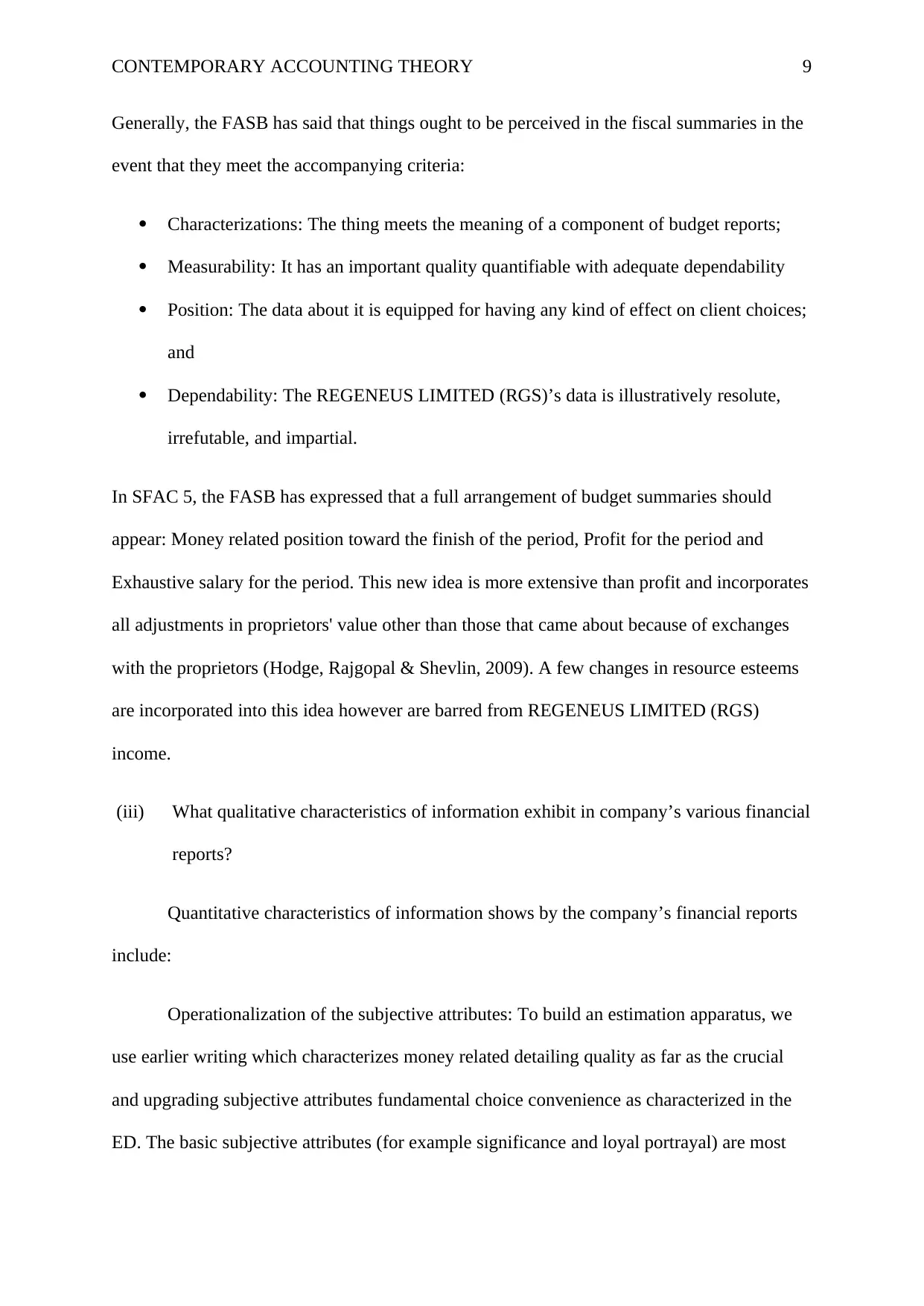
CONTEMPORARY ACCOUNTING THEORY 9
Generally, the FASB has said that things ought to be perceived in the fiscal summaries in the
event that they meet the accompanying criteria:
Characterizations: The thing meets the meaning of a component of budget reports;
Measurability: It has an important quality quantifiable with adequate dependability
Position: The data about it is equipped for having any kind of effect on client choices;
and
Dependability: The REGENEUS LIMITED (RGS)’s data is illustratively resolute,
irrefutable, and impartial.
In SFAC 5, the FASB has expressed that a full arrangement of budget summaries should
appear: Money related position toward the finish of the period, Profit for the period and
Exhaustive salary for the period. This new idea is more extensive than profit and incorporates
all adjustments in proprietors' value other than those that came about because of exchanges
with the proprietors (Hodge, Rajgopal & Shevlin, 2009). A few changes in resource esteems
are incorporated into this idea however are barred from REGENEUS LIMITED (RGS)
income.
(iii) What qualitative characteristics of information exhibit in company’s various financial
reports?
Quantitative characteristics of information shows by the company’s financial reports
include:
Operationalization of the subjective attributes: To build an estimation apparatus, we
use earlier writing which characterizes money related detailing quality as far as the crucial
and upgrading subjective attributes fundamental choice convenience as characterized in the
ED. The basic subjective attributes (for example significance and loyal portrayal) are most
Generally, the FASB has said that things ought to be perceived in the fiscal summaries in the
event that they meet the accompanying criteria:
Characterizations: The thing meets the meaning of a component of budget reports;
Measurability: It has an important quality quantifiable with adequate dependability
Position: The data about it is equipped for having any kind of effect on client choices;
and
Dependability: The REGENEUS LIMITED (RGS)’s data is illustratively resolute,
irrefutable, and impartial.
In SFAC 5, the FASB has expressed that a full arrangement of budget summaries should
appear: Money related position toward the finish of the period, Profit for the period and
Exhaustive salary for the period. This new idea is more extensive than profit and incorporates
all adjustments in proprietors' value other than those that came about because of exchanges
with the proprietors (Hodge, Rajgopal & Shevlin, 2009). A few changes in resource esteems
are incorporated into this idea however are barred from REGENEUS LIMITED (RGS)
income.
(iii) What qualitative characteristics of information exhibit in company’s various financial
reports?
Quantitative characteristics of information shows by the company’s financial reports
include:
Operationalization of the subjective attributes: To build an estimation apparatus, we
use earlier writing which characterizes money related detailing quality as far as the crucial
and upgrading subjective attributes fundamental choice convenience as characterized in the
ED. The basic subjective attributes (for example significance and loyal portrayal) are most
⊘ This is a preview!⊘
Do you want full access?
Subscribe today to unlock all pages.

Trusted by 1+ million students worldwide
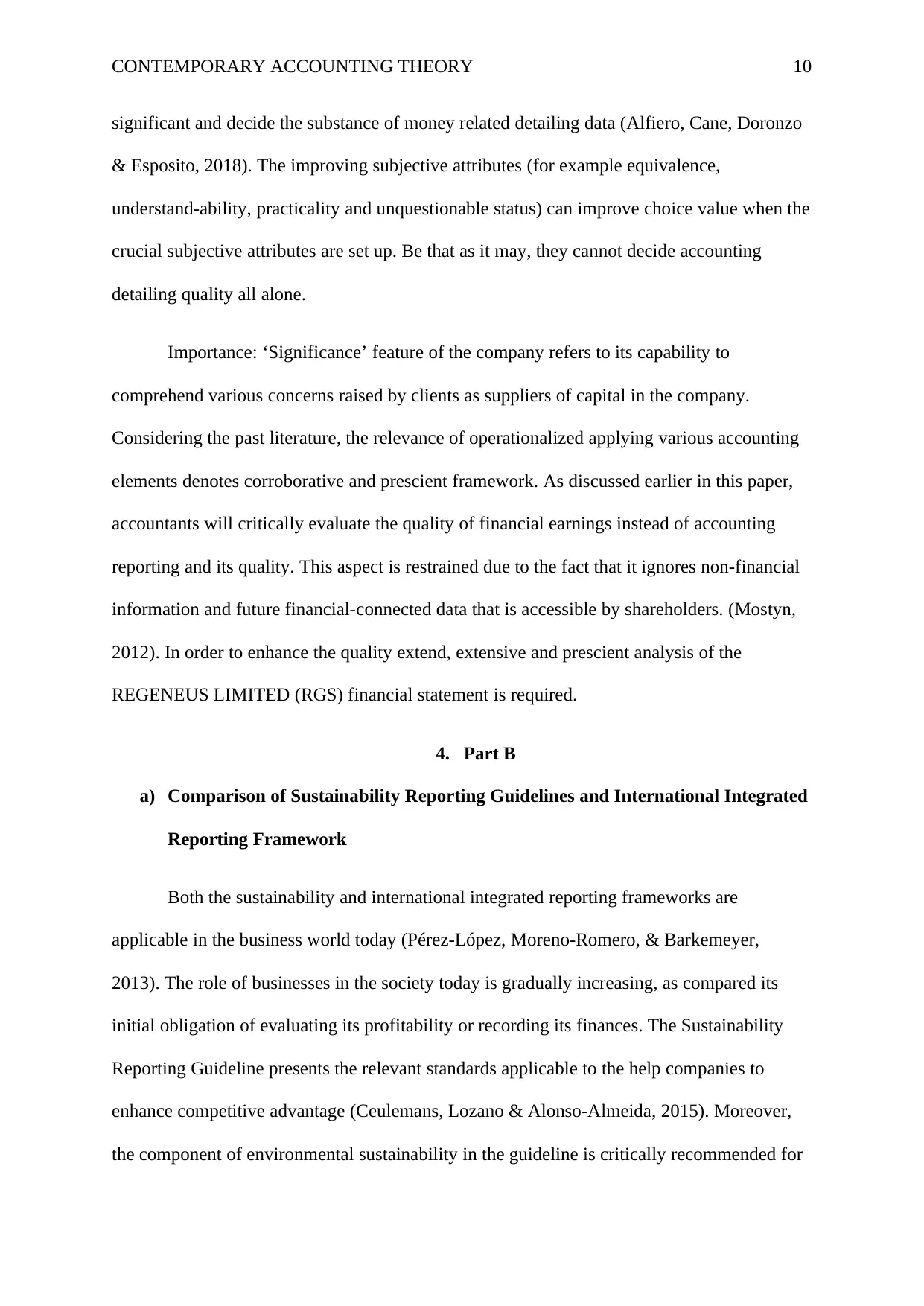
CONTEMPORARY ACCOUNTING THEORY 10
significant and decide the substance of money related detailing data (Alfiero, Cane, Doronzo
& Esposito, 2018). The improving subjective attributes (for example equivalence,
understand-ability, practicality and unquestionable status) can improve choice value when the
crucial subjective attributes are set up. Be that as it may, they cannot decide accounting
detailing quality all alone.
Importance: ‘Significance’ feature of the company refers to its capability to
comprehend various concerns raised by clients as suppliers of capital in the company.
Considering the past literature, the relevance of operationalized applying various accounting
elements denotes corroborative and prescient framework. As discussed earlier in this paper,
accountants will critically evaluate the quality of financial earnings instead of accounting
reporting and its quality. This aspect is restrained due to the fact that it ignores non-financial
information and future financial-connected data that is accessible by shareholders. (Mostyn,
2012). In order to enhance the quality extend, extensive and prescient analysis of the
REGENEUS LIMITED (RGS) financial statement is required.
4. Part B
a) Comparison of Sustainability Reporting Guidelines and International Integrated
Reporting Framework
Both the sustainability and international integrated reporting frameworks are
applicable in the business world today (Pérez-López, Moreno-Romero, & Barkemeyer,
2013). The role of businesses in the society today is gradually increasing, as compared its
initial obligation of evaluating its profitability or recording its finances. The Sustainability
Reporting Guideline presents the relevant standards applicable to the help companies to
enhance competitive advantage (Ceulemans, Lozano & Alonso-Almeida, 2015). Moreover,
the component of environmental sustainability in the guideline is critically recommended for
significant and decide the substance of money related detailing data (Alfiero, Cane, Doronzo
& Esposito, 2018). The improving subjective attributes (for example equivalence,
understand-ability, practicality and unquestionable status) can improve choice value when the
crucial subjective attributes are set up. Be that as it may, they cannot decide accounting
detailing quality all alone.
Importance: ‘Significance’ feature of the company refers to its capability to
comprehend various concerns raised by clients as suppliers of capital in the company.
Considering the past literature, the relevance of operationalized applying various accounting
elements denotes corroborative and prescient framework. As discussed earlier in this paper,
accountants will critically evaluate the quality of financial earnings instead of accounting
reporting and its quality. This aspect is restrained due to the fact that it ignores non-financial
information and future financial-connected data that is accessible by shareholders. (Mostyn,
2012). In order to enhance the quality extend, extensive and prescient analysis of the
REGENEUS LIMITED (RGS) financial statement is required.
4. Part B
a) Comparison of Sustainability Reporting Guidelines and International Integrated
Reporting Framework
Both the sustainability and international integrated reporting frameworks are
applicable in the business world today (Pérez-López, Moreno-Romero, & Barkemeyer,
2013). The role of businesses in the society today is gradually increasing, as compared its
initial obligation of evaluating its profitability or recording its finances. The Sustainability
Reporting Guideline presents the relevant standards applicable to the help companies to
enhance competitive advantage (Ceulemans, Lozano & Alonso-Almeida, 2015). Moreover,
the component of environmental sustainability in the guideline is critically recommended for
Paraphrase This Document
Need a fresh take? Get an instant paraphrase of this document with our AI Paraphraser
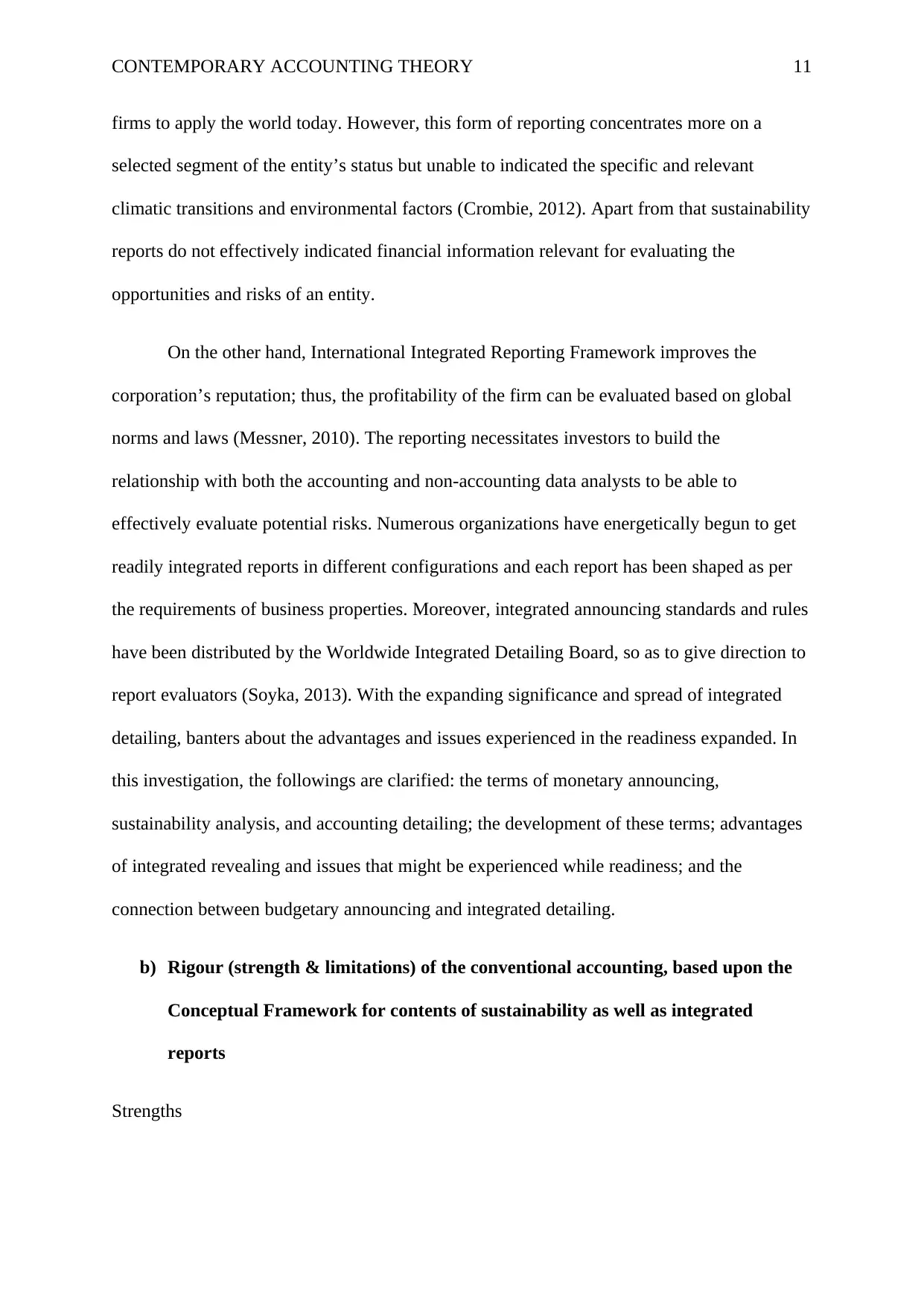
CONTEMPORARY ACCOUNTING THEORY 11
firms to apply the world today. However, this form of reporting concentrates more on a
selected segment of the entity’s status but unable to indicated the specific and relevant
climatic transitions and environmental factors (Crombie, 2012). Apart from that sustainability
reports do not effectively indicated financial information relevant for evaluating the
opportunities and risks of an entity.
On the other hand, International Integrated Reporting Framework improves the
corporation’s reputation; thus, the profitability of the firm can be evaluated based on global
norms and laws (Messner, 2010). The reporting necessitates investors to build the
relationship with both the accounting and non-accounting data analysts to be able to
effectively evaluate potential risks. Numerous organizations have energetically begun to get
readily integrated reports in different configurations and each report has been shaped as per
the requirements of business properties. Moreover, integrated announcing standards and rules
have been distributed by the Worldwide Integrated Detailing Board, so as to give direction to
report evaluators (Soyka, 2013). With the expanding significance and spread of integrated
detailing, banters about the advantages and issues experienced in the readiness expanded. In
this investigation, the followings are clarified: the terms of monetary announcing,
sustainability analysis, and accounting detailing; the development of these terms; advantages
of integrated revealing and issues that might be experienced while readiness; and the
connection between budgetary announcing and integrated detailing.
b) Rigour (strength & limitations) of the conventional accounting, based upon the
Conceptual Framework for contents of sustainability as well as integrated
reports
Strengths
firms to apply the world today. However, this form of reporting concentrates more on a
selected segment of the entity’s status but unable to indicated the specific and relevant
climatic transitions and environmental factors (Crombie, 2012). Apart from that sustainability
reports do not effectively indicated financial information relevant for evaluating the
opportunities and risks of an entity.
On the other hand, International Integrated Reporting Framework improves the
corporation’s reputation; thus, the profitability of the firm can be evaluated based on global
norms and laws (Messner, 2010). The reporting necessitates investors to build the
relationship with both the accounting and non-accounting data analysts to be able to
effectively evaluate potential risks. Numerous organizations have energetically begun to get
readily integrated reports in different configurations and each report has been shaped as per
the requirements of business properties. Moreover, integrated announcing standards and rules
have been distributed by the Worldwide Integrated Detailing Board, so as to give direction to
report evaluators (Soyka, 2013). With the expanding significance and spread of integrated
detailing, banters about the advantages and issues experienced in the readiness expanded. In
this investigation, the followings are clarified: the terms of monetary announcing,
sustainability analysis, and accounting detailing; the development of these terms; advantages
of integrated revealing and issues that might be experienced while readiness; and the
connection between budgetary announcing and integrated detailing.
b) Rigour (strength & limitations) of the conventional accounting, based upon the
Conceptual Framework for contents of sustainability as well as integrated
reports
Strengths
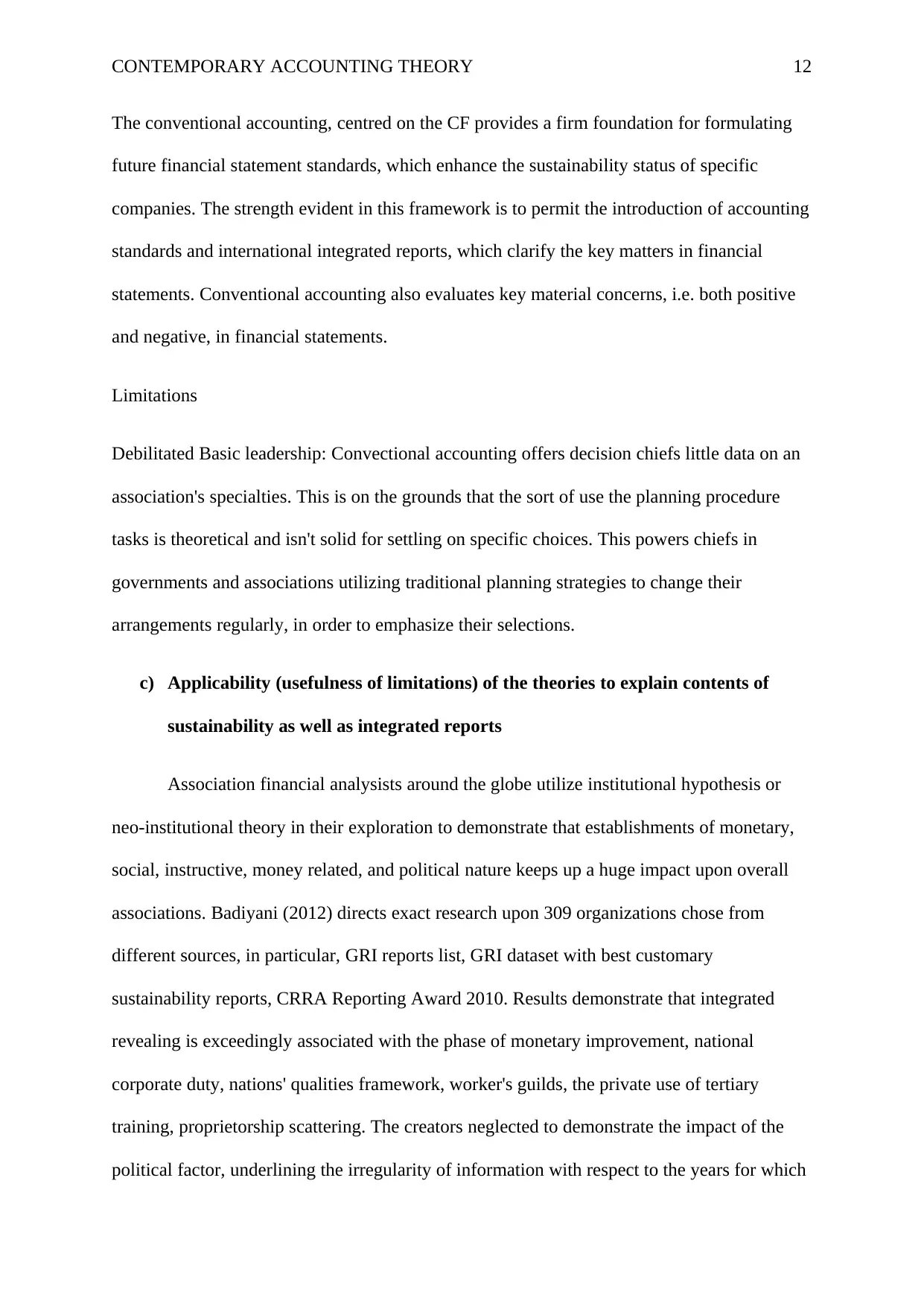
CONTEMPORARY ACCOUNTING THEORY 12
The conventional accounting, centred on the CF provides a firm foundation for formulating
future financial statement standards, which enhance the sustainability status of specific
companies. The strength evident in this framework is to permit the introduction of accounting
standards and international integrated reports, which clarify the key matters in financial
statements. Conventional accounting also evaluates key material concerns, i.e. both positive
and negative, in financial statements.
Limitations
Debilitated Basic leadership: Convectional accounting offers decision chiefs little data on an
association's specialties. This is on the grounds that the sort of use the planning procedure
tasks is theoretical and isn't solid for settling on specific choices. This powers chiefs in
governments and associations utilizing traditional planning strategies to change their
arrangements regularly, in order to emphasize their selections.
c) Applicability (usefulness of limitations) of the theories to explain contents of
sustainability as well as integrated reports
Association financial analysists around the globe utilize institutional hypothesis or
neo-institutional theory in their exploration to demonstrate that establishments of monetary,
social, instructive, money related, and political nature keeps up a huge impact upon overall
associations. Badiyani (2012) directs exact research upon 309 organizations chose from
different sources, in particular, GRI reports list, GRI dataset with best customary
sustainability reports, CRRA Reporting Award 2010. Results demonstrate that integrated
revealing is exceedingly associated with the phase of monetary improvement, national
corporate duty, nations' qualities framework, worker's guilds, the private use of tertiary
training, proprietorship scattering. The creators neglected to demonstrate the impact of the
political factor, underlining the irregularity of information with respect to the years for which
The conventional accounting, centred on the CF provides a firm foundation for formulating
future financial statement standards, which enhance the sustainability status of specific
companies. The strength evident in this framework is to permit the introduction of accounting
standards and international integrated reports, which clarify the key matters in financial
statements. Conventional accounting also evaluates key material concerns, i.e. both positive
and negative, in financial statements.
Limitations
Debilitated Basic leadership: Convectional accounting offers decision chiefs little data on an
association's specialties. This is on the grounds that the sort of use the planning procedure
tasks is theoretical and isn't solid for settling on specific choices. This powers chiefs in
governments and associations utilizing traditional planning strategies to change their
arrangements regularly, in order to emphasize their selections.
c) Applicability (usefulness of limitations) of the theories to explain contents of
sustainability as well as integrated reports
Association financial analysists around the globe utilize institutional hypothesis or
neo-institutional theory in their exploration to demonstrate that establishments of monetary,
social, instructive, money related, and political nature keeps up a huge impact upon overall
associations. Badiyani (2012) directs exact research upon 309 organizations chose from
different sources, in particular, GRI reports list, GRI dataset with best customary
sustainability reports, CRRA Reporting Award 2010. Results demonstrate that integrated
revealing is exceedingly associated with the phase of monetary improvement, national
corporate duty, nations' qualities framework, worker's guilds, the private use of tertiary
training, proprietorship scattering. The creators neglected to demonstrate the impact of the
political factor, underlining the irregularity of information with respect to the years for which
⊘ This is a preview!⊘
Do you want full access?
Subscribe today to unlock all pages.

Trusted by 1+ million students worldwide
1 out of 20
Related Documents
Your All-in-One AI-Powered Toolkit for Academic Success.
+13062052269
info@desklib.com
Available 24*7 on WhatsApp / Email
![[object Object]](/_next/static/media/star-bottom.7253800d.svg)
Unlock your academic potential
Copyright © 2020–2025 A2Z Services. All Rights Reserved. Developed and managed by ZUCOL.



